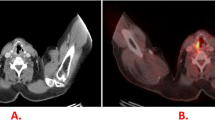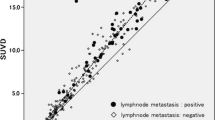Abstract
Objective
The aim of this study is to clarify the difference of F-18 FDG uptake kinetics between FDG-avid non-small-cell lung cancer (NSCLC) and benign lesions associated with various etiologies on dual-time point PET/CT scan, and to determine the optimal parameter for differentiation.
Materials and methods
The materials were 76 FDG-avid solitary NSCLC in 76 patients and 57 FDG-avid solitary benign lesions associated with various etiologies in 61 patients. FDG PET/CT scan was performed at 60 and 120 min after intravenous injection of 4.4 MBq/kg F-18 FDG. The maximum standardized uptake value (SUVmax) on early and delayed scans and the percent change of SUVmax (%ΔSUVmax) between the two time points were measured. The optimal differential parameter was determined by receiver-operating characteristic curve analysis and evaluation of diagnostic accuracy.
Results
The mean ± SD of early SUV max, delayed SUVmax and %ΔSUVmax were 8.3 ± 5.2, and 10.2 ± 6.5, and 21.9% ± 18.9 in FDG-avid NSCLC, and 3.8 ± 3.2, 4.0 ± 3.7, and 11.3% ± 26.0 in FDG-avid benign lesions, respectively. Delayed SUVmax in NSCLC was significantly higher than early SUVmax (P < 0.0001); while not different in benign lesions. Percent change of SUVmax in NSCLC was also significantly higher than that in benign lesions (P < 0.01). The optimal parameter for the differentiation was delayed SUVmax > 5.5 and yielded sensitivity of 77.6%, specificity of 80.7% and accuracy of 78.9%, which provided better differentiation than the use of %ΔSUVmax or the traditional parameter of early SUVmax > 2.5. However, 11 (19.2%) benign lesions were indistinguishable from NSCLC.
Conclusion
Although delayed PET/CT scan enhances the difference of FDG uptake between FDG-avid NSCLC and benign lesions, and the use of delayed SUVmax > 5.5 appears to improve the differentiation of these hypermetabolic lesions compared with an early scan, careful interpretation and management for correct differentiation are still required.






Similar content being viewed by others
References
Shulkin AN. Management of the indeterminate solitary pulmonary nodule: a co-operative study. Ann Thorac Surg. 1993;56:743–4.
Odell MJ, Reid KR. Does percutaneous fine-needle aspiration biopsy aid in the diagnosis and surgical management of lung masses? Can J Surg. 1999;42:297–301.
Tsukada H, Satou T, Iwashima A, Souma T. Diagnostic accuracy of CT-guided automated needle biopsy of lung nodules. Am J Roentgenol. 2000;175:239–43.
Dewan NA, Reeb SD, Gupta NC, Gobar LS, Scott WJ. PET-FDG imaging and transthoracic needle lung aspiration biopsy in evaluation of pulmonary lesions. A comparative risk-benefit analysis. Chest. 1995;108:441–6.
Gould MK, Maclean CC, Kuschner WG, Rydzak CE, Owens DK. Accuracy of positron emission tomography for diagnosis of pulmonary nodules and mass lesions: a meta-analysis. JAMA. 2001;285:914–24.
Schrevens L, Lorent N, Dooms C, Vansteenkiste J. The role of PET scan in diagnosis, staging, and management of non-small cell lung cancer. Oncologist. 2004;9:633–43.
Hamberg LM, Hunter GJ, Alpert NM, Choi NC, Babich JW, Fischman AJ. The dose uptake ratio as an index of glucose metabolism: useful parameter or oversimplification? J Nucl Med. 1994;35:1308–12.
Fischer BM, Mortensen J, Hojgaard L. Positron emission tomography in the diagnosis and staging of lung cancer: a systematic, quantitative review. Lancet Oncol. 2001;2:659–66.
Mavi A, Lakhani P, Zhuang H, Gupta NC, Alavi A. Fluorodeoxyglucose-PET in characterizing solitary pulmonary nodules, assessing pleural diseases, and the initial staging, restaging, therapy planning, and monitoring response of lung cancer. Radiol Clin North Am. 2005;43:1–21.
Shon IH, O’doherty MJ, Maisey MN. Positron emission tomography in lung cancer. Semin Nucl Med. 2002;32:240–71.
Bunyaviroch T, Coleman RE. PET evaluation of lung cancer. J Nucl Med. 2006;47:451–69.
Pitman AG, Hicks RJ, Binns DS, Ware RE, Kalff V, McKenzie AF, et al. Positron emission tomography in pulmonary masses where tissue diagnosis is unhelpful or not possible. Med J Aust. 2001;175:303–7.
Fletcher JW, Djulbegovic B, Soares HP, Barry A, Siegel BA, Lowe VJ, et al. Recommendations on the Use of 18F-FDG PET in Oncology. J Nucl Med. 2008;49:480–508.
Blodgett T, Meltzer CC, Townsend DW. PET/CT: form and function. Radiology. 2007;242:360–85.
Bury T, Dowlati A, Paulus P, Corhay JL, Benoit T, Kayembe JM, et al. Evaluation of the solitary pulmonary nodule by positron emission tomography imaging. Eur Respir J. 1996;9:410–4.
Alavi A, Gupta N, Alberini JL, Hickeson M, Adam LE, Bhargava P, et al. Positron emission tomography imaging in nonmalignant thoracic disorders. Semin Nucl Med. 2002;32:293–321.
Bakheet SM, Powe J. Benign causes of 18-FDG uptake on whole body imaging. Semin Nucl Med. 1998;28:352–8.
Zhuang H, Pourdehnad M, Lambright ES, Yamamoto AJ, Lanuti M, Li P, et al. Dual time point 18F-FDG PET imaging for differentiating malignant from inflammatory processes. J Nucl Med. 2001;42:1412–7.
Lan XL, Zhang YX, Wu ZJ, Jia Q, Wei H, Gao ZR. The value of dual time point 18F-FDG PET imaging for the differentiation between malignant and benign lesions. Clin Radiol. 2008;63:756–64.
Goo JM, Im JG, Do KH, Yeo JS, Seo JB, Kim HY, et al. Pulmonary tuberculoma evaluated by means of FDG PET: findings in 10 cases. Radiology. 2000;216:117–21.
Bakheet SM, Saleem M, Powe J, Al-Amro A, Larsson SG, Mahassin Z. F-18 fluorode-oxyglucose chest uptake in lung inflammation and infection. Clin Nucl Med. 2000;25:273–8.
Brudin LH, Valind SO, Rhodes CG, Pantin CF, Sweatman M, Jones T, et al. Fluorine-18 deoxyglucose uptake in sarcoidosis measured with positron emission tomography. Eur J Nucl Med. 1994;21:297–305.
Demura Y, Tsuchida T, Ishizaki T, Mizuno S, Totani Y, Ameshina S, et al. 18F-FDG accumulation with PET for differentiation between benign and malignant lesions in the thorax. J Nucl Med. 2003;44:540–8.
Alkhawaldeh K, Bural G, Kumar R, Alavi A. Impact of dual-time-point 18F-FDG PET imaging and partial volume correction in the assessment of solitary pulmonary nodules. Eur J Nucl Med Mol Imaging. 2008;35:246–52.
Lowe VJ, DeLong DM, Hoffman JM, Coleman RE. Optimum scanning protocol for FDG-PET evaluation of pulmonary malignancy. J Nucl Med. 1995;36:883–7.
Xiu Y, Bhutani C, Dhurairaj T, Yu JQ, Dadparvar S, Reddy S, et al. Dual-time point FDG PET imaging in the evaluation of pulmonary nodules with minimally increased metabolic activity. Clin Nucl Med. 2007;32:101–5.
Matthies A, Hickeson M, Cuchiara A, Alavi A. Dual time point 18F-FDG PET for the evaluation of pulmonary nodules. J Nucl Med. 2002;43:871–5.
Conrad GR, Sinha P. Narrow time window dual-point 18F-FDG PET for the diagnosis of thoracic malignancy. Nucl Med Commun. 2003;24:1129–37.
Chen CJ, Lee BF, Yao WJ, Cheng L, Wu PS, Chu CL, et al. Dual-phase 18F-FDG PET in the diagnosis of pulmonary nodules with an initial standard uptake value less than 2.5. AJR Am J Roentgenol. 2008;191:475–9.
Kubota K, Matsuzawa T, Fujiwara T, Ito M, Hatazawa J, Ishiwata K, et al. Differential diagnosis of lung tumor with positron emission tomography: a prospective study. J Nucl Med. 1990;31:1927–32.
Beuthien-Baumann B, Hamacher K, Oberdorfer F, Steinbach J. Preparation of fluorine-18 labelled sugars and derivatives and their application as tracer for positron-emission-tomography. Carbohydr Res. 2000;327:107–18.
Browne J, De Pierro A. A row-action alternative to the EM algorithm for maximizing likelihood in emission tomography. IEEE Trans Med Imaging. 1996;15:687–99.
Núñez R, Kalapparambath A, Varela J. Improvement in sensitivity with delayed imaging of pulmonary lesions with FDG-PET. Rev Esp Med Nucl. 2007;26:196–207.
Kubota R, Yamada S, Kubota K, Ishiwata K, Tamahashi N, Ido T. Intratumoral distribution of fluorine-18-fluorodeoxyglucose in vivo: high accumulation in macrophages and granulation tissues studied by microautoradiography. J Nucl Med. 1992;33:1972–80.
Hubner KF, Buonocore E, Gould HR, Thie J, Smith GT, Stephens S, et al. Differentiating benign from malignant lung lesions using “quantitative” parameters of FDG PET images. Clin Nucl Med. 1996;21:941–9.
Tsushima Y, Tateishi U, Uno H, Takeuchi M, Terauchi T, Goya T, et al. Diagnostic performance of PET/CT in differentiation of malignant and benign non-solid solitary pulmonary nodules. Ann Nucl Med. 2008;22:571–7.
Higashi K, Ueda Y, Seki H, Yuasa K, Oguchi M, Noguchi T, et al. Fluorine-18-FDG PET imaging is negative in bronchioalveolar carcinoma. J Nucl Med. 1998;39:1016–20.
Bryant AS, Cerfolio RJ. The maximum standardized uptake values on integrated FDG-PET/CT is useful in differentiating benign from malignant pulmonary nodules. Ann Thorac Surg. 2006;82:1016–20.
Hustinx R, Smith RJ, Benard F, Rosenthal DI, Machtay M, Farber LA, et al. Dual time point fluorine-18 fluorodeoxyglucose positron emission tomography: a potential method to differentiate malignancy from inflammation and normal tissue in head and neck. Eur J Nucl Med. 1999;26:1345–8.
Uesaka D, Demura Y, Ishizaki T, Ameshima S, Miyamori I, Sasaki M, et al. Evaluation of dual-time-point 18F-FDG PET for staging in patients with lung cancer. J Nucl Med. 2008;49:1606–12.
Mavi A, Urhan M, Yu JQ, Zhuang H, Houseni M, Cermik TF, et al. Dual time point 18F-FDG PET imaging detects breast cancer with high sensitivity and correlates well with histologic subtypes. J Nucl Med. 2006;47:1440–6.
Torizuka T, Zasadny KR, Recker B, Wahl RL. Untreated primary lung and breast cancers: correlation between F-18 FDG kinetic rate constants and findings of in vitro studies. Radiology. 1998;207:767–74.
Fin L, Daouk J, Morvan J, Bailly P, Esper I, Saidi L, et al. Initial clinical results for breath-hold CT-based processing of respiratory-gated PET acquisitions. Eur J Nucl Med Mol Imaging. 2008;35:1971–80.
Author information
Authors and Affiliations
Corresponding author
Rights and permissions
About this article
Cite this article
Suga, K., Kawakami, Y., Hiyama, A. et al. Dual-time point 18F-FDG PET/CT scan for differentiation between 18F-FDG-avid non-small cell lung cancer and benign lesions. Ann Nucl Med 23, 427–435 (2009). https://doi.org/10.1007/s12149-009-0260-6
Received:
Accepted:
Published:
Issue Date:
DOI: https://doi.org/10.1007/s12149-009-0260-6




